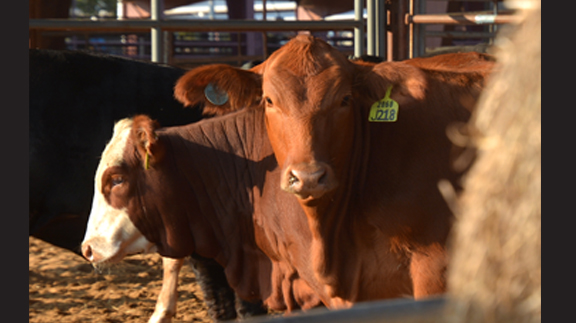Farm & Ranch
Amid historic-high cattle prices, producers can capture extra dollars

By: Blair Fannin
Writer: Blair Fannin, 979-845-2259, [email protected]
Contact: Dr. Levi Russell, 361-265-9203, [email protected]
BRENHAM – Though cattle prices have reached historic highs, there could be potential to make extra dollars and possibly add more young cows to a herd at current prices, according to a Texas A&M AgriLife Extension Service economist.
Dr. Levi Russell, AgriLife Extension economist in Corpus Christi, told attendees at the recent South Central Texas Cow-Calf Clinic in Brenham the cattle market has continued its historic price run due to supply constraints.
“Part of the reason for these high prices is low supply,” he said. “Overall, it doesn’t appear these prices are going to level off anytime soon due to the fact there are fewer beef cows out there.”
Russell said data indicates continued strong consumer demand, both domestically and for exports.
“This makes most folks think these high prices will continue to hold,” he said.
Prices for 700-pound to 800-pound steers in the first quarter of 2015 suggest $229 per hundredweight to $333 per hundredweight, according to Dr. David Anderson, AgriLife Extension livestock economist, College Station.
Those prices are expected to remain relatively steady throughout 2015 as more ranchers continue to slowly rebuild herds, Russell said.
Russell said simple management practices such as castrating calves can add more dollars to a rancher’s pocket.
“I want to emphasize there’s some real value in castrating your calves,” Russell said.
He said those who do not castrate will receive discounts up to 8 percent.
“Those who don’t choose to castrate would be better off selling those calves before they reach 600 pounds,” he said.
Russell also demonstrated the Bid Price Estimator for Beef Cows, a spreadsheet program that can assist beef cattle producers when deciding to buy replacement cattle. The program allows producers to input an expected rate of return against the net cash outlay for buying replacement cattle.
The spreadsheet takes into consideration annual operating costs as well as financing information.
“People are saying females are expensive to go out and buy right now,” Russell said. “But that net present value is what indicates your return on investment.”
To access the spreadsheet, visit http://bit.ly/1jOtkRj .
-30-
Farm & Ranch
Hazards of Backyard Poultry

By Barry Whitworth, DVM
Having backyard poultry is a popular agriculture enterprise. According to the United States Department of Agriculture, 0.8 percent of all households in the United States have chickens. People keep chickens for a variety of reasons with table eggs being one of the more common reasons.
Unfortunately, some of these poultry producers are not aware of the hazards that come with keeping poultry because many times they carry pathogens but appear healthy.
Chickens are carriers of several zoonotic diseases. These are diseases that can be passed from animals to humans. According to a recent survey in Pennsylvania, a majority of backyard poultry producers were aware of the dangers of avian influenza. However, this study also revealed that far fewer producers were aware of the risk of possible exposure to Salmonella and Campylobacter.
The lack of knowledge about the hazards of raising poultry likely contributes to the continued issues of Salmonella outbreaks associated with backyard poultry. In 2023, the Centers for Disease Control and Prevention reported 1,072 illnesses of Salmonella linked to backyard poultry, and 272 of those patients required hospitalization. Oklahoma reported 43 individuals with the disease.
To read more, pick up a copy of the April issue of NTFR magazine. To subscribe by mail, call 940-872-5922.
Farm & Ranch
Ag Elsewhere: Wyoming

By Tressa Lawrence
Babies are tucked away in every nook and cranny. Many ranchers across Wyoming have baby animals popping up all over this time of year.
Farm & Ranch
Ag Elsewhere: Montana

By Lindsey Monk
Another load of grain in to keep feeding the calves until the green grass can really start popping.
-

 Country Lifestyles1 year ago
Country Lifestyles1 year agoScott & Stacey Schumacher: A Growth Mindset
-

 Equine7 months ago
Equine7 months agoThe Will to Win
-

 Country Lifestyles7 years ago
Country Lifestyles7 years agoStyle Your Profile – What your style cowboy hat says about you and new trends in 2017
-

 Country Lifestyles4 years ago
Country Lifestyles4 years agoAmber Crawford, Breakaway Roper
-

 HOME7 years ago
HOME7 years agoGrazing North Texas – Wilman Lovegrass
-

 Country Lifestyles7 years ago
Country Lifestyles7 years agoDecember 2016 Profile, Rusty Riddle – The Riddle Way
-

 Country Lifestyles8 years ago
Country Lifestyles8 years agoJune 2016 Profile – The man behind the mic: Bob Tallman
-

 Outdoor9 years ago
Outdoor9 years agoButtercup or Primrose?






